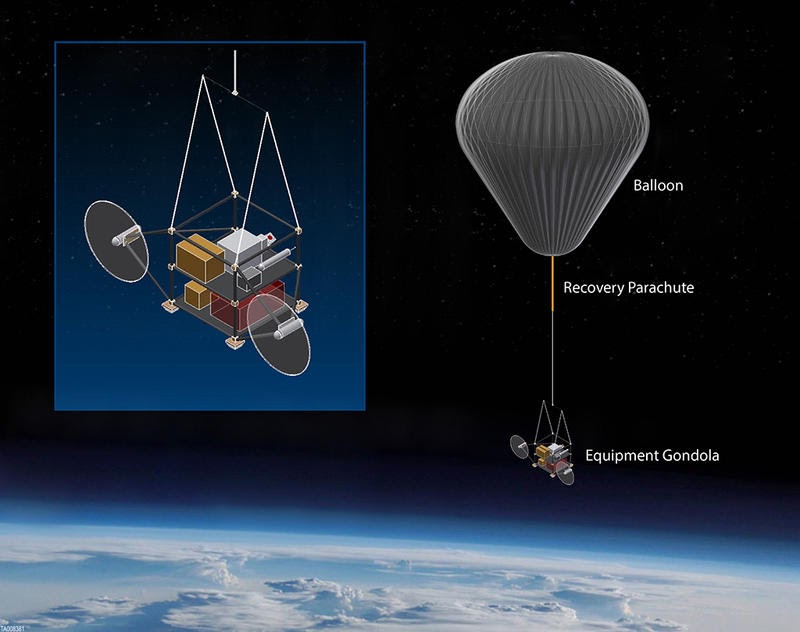On Climate Change and (Active) Climate Management
Nothing on this page is factually controversial. However, many things in this post make for uncomfortable reading. And, climate discourse is now so politicized that many factual statements are taken as dog whistles. For example, in what follows I will state that climate has always been changing, and has in fact never been stable for very long.
This is 100% true, but people interpret this as if the writer means that our current climate change is not caused by human beings, or is nothing to worry about.
Yet this is not what I mean. So before I embark on this summary of where we are in terms of climate and active climate management, let me make it absolutely clear that the facts have 100% convinced me that climate change is real, extremely worrying and that we are absolutely the main cause. On top of that, the 2023 climate anomaly is exceptionally scary.
Nothing you’ll read below is new. But, on the other hand, it is also rare to find a complete picture of what is going on. Also, some of the climate/geo-engineering stuff is not as widely known as it should be, and it might shock you.
Here is what we’ll be going over:
- Where are we?
- Times we already messed up the global environment
- Are we rocking the climate boat?
- Yes we are, but how stable is the climate? Not very
- What is happening now? Or: the 2023 anomaly
- What we are doing about it / claiming to do about it: “Abstinence only”
- Given that solar is now by far the cheapest form of energy, we CAN do something
- But it won’t happen soon enough
- Carbon capture / storage: options
- Solar Radiation Management / geo-engineering is very cheap and very quickly shows effects
- But what effects? Signs are reasonably good, but far more research is needed
- Exciting times: “Greenfinger”
- We’re building an actual clean future!
- Rounding off / further reading
Many thanks are due to the various proofreaders. I’m especially indebted to #powerdns, the chat community of my former company. The help is most appreciated! Meanwhile, any mistakes remain mine, and I’d love to hear about them on bert@hubertnet.nl
UPDATE: After this post generated some questions, I wrote a huge page on how CO₂ really warms our atmosphere.
So where are we?
For the past few centuries, we’ve been combusting and processing ever larger amounts of fuels and chemicals, and putting the output in the atmosphere or biosphere.
The sheer numbers are staggering. We may experience the Earth and the climate as so large that we don’t really impact it, but that mental model is wrong. As an example, the extremely important nitrogen cycle has been cycling for hundreds of millions of years, and it powers all of nature. Bacteria ‘fix’ nitrogen from the atmosphere, after which plants can use it. The nitrogen cycle used to carry around 100 million tonnes/year for the whole planet. These days, we’ve added 150 million tonnes/year to that - more than doubling the original flow.
We are not a small additive to the climate, we’ve become an integral part of the “Earth system” (a term happily lifted from The Planet Remade by Oliver Morton).
 A huge ship, weighing around 125 kilotons, or somewhat less than 2 million people
A huge ship, weighing around 125 kilotons, or somewhat less than 2 million people
Putting it another way, the climate may feel like we are standing on a huge ship where we can jump up and down as much as we want and the ship won’t budge. But it isn’t like that. It is more like we are standing on a medium sized boat which we can tip over if we jump too much.
Times when it went wrong already
As we burn and process chemicals, periodically this has led to immediate problems. The burning of peat and coal for example made city life very hard. Pollution led to lots of disease and very noticeable breathing problems. Shifts to cleaner fuels, and mandating cleaner cars, have solved these problems in many places. Once these things become too “in your face”, action typically follows.
 A statue degraded by acid rain. Source: Wikipedia user Nino Barbieri
A statue degraded by acid rain. Source: Wikipedia user Nino Barbieri
Similarly, in the 1970s and 1980s, emissions of sulfur dioxide and nitrogen oxide were making rain so acidic that it was leading to visible deterioration of paint, statues and steel structures such as bridges. This may have been somewhat harder to ignore than the detrimental effects on insects, plants and aquatic animals. Through legislation, industry was forced to reduce these emissions, and it actually helped.
In the late 1970s it was discovered that the ozone layer, which protects us against harmful UV radiation, was being depleted above the poles. If left unchecked, that would cause more and more problems if the ‘ozone hole’ continued to grow. The cause was identified as chemicals used in spray cans and refrigerators. I remember living through this period when everyone knew the cause of the problem, but industry claimed to need more time to adapt. Through the 1987 Montreal Protocol, the production of these ozone depleting chemicals has been phased out. The ozone layer has greatly recovered meanwhile.
Carbon Dioxide
Through the examples above, it is clear we humans can affect the atmosphere globally, causing significant problems. Because of this, large parts of the world have made tremendous progress moving from dirty to less dirty fuels, and filtering out ever more of their harmful emissions.
What has not changed however is the emission of carbon dioxide, which is currently happening at a staggering 35 billion tons per year. This stunning amount of CO₂ corresponds to around 10 gigatons of carbon. To put this number in perspective, this is around 15% of the amount of carbon used by plants annually:
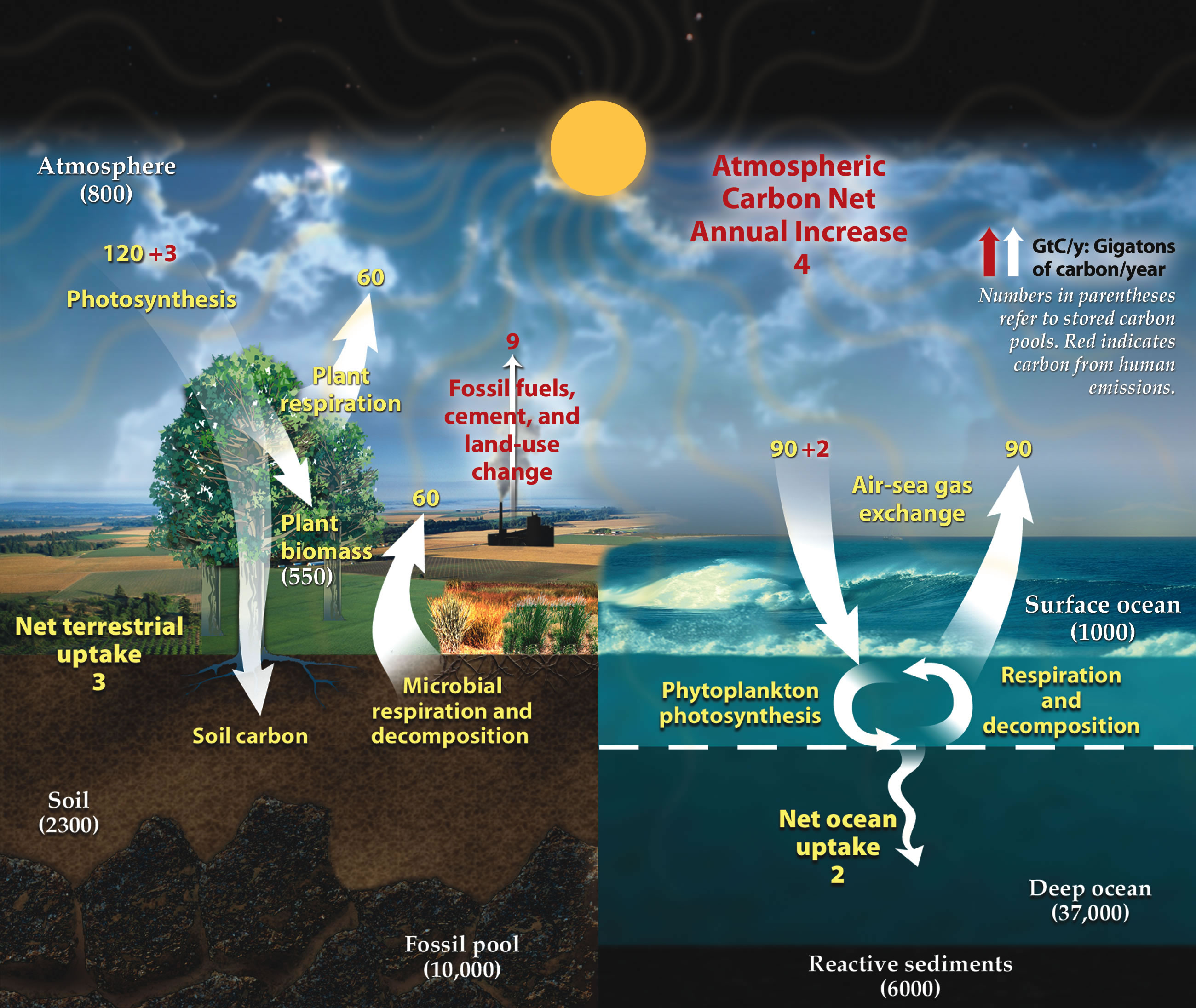 Source: Wikipedia, adapted from U.S. DOE, Biological and Environmental Research Information System
Source: Wikipedia, adapted from U.S. DOE, Biological and Environmental Research Information System
Note that this picture, which shows the Carbon cycle, lists the annual number of gigatons of carbon (C), and not gigatons of CO₂. The red numbers denote flows caused by human activities.
From this we can see that of the (now) 10 gigatons of carbon we add to the atmosphere, around half gets absorbed by soil and oceans. As of 2023, the concentration of CO₂ in the atmosphere is around 0.042%, or 420 parts per million (ppm). Every year this number goes up by around 2 ppm. If the ocean and soil were to be saturated, this increase would be around 4ppm, or 1% per year.
Note that from these huge numbers of gigatons, it is clear we won’t solve climate change by banning plastic straws, banning private jets or even by planting a trillion trees. The scope is just too huge for such niceties to help appreciably.
For completeness, although the story is more complicated than usually told, the increase in atmospheric CO₂ is causing global warming. Models tell us that the more CO₂ we put in the atmosphere, the hotter it will get. So we should stop doing that.
So how stable is the climate?
It is clear that our emissions are of a planetary scale. We are seriously rocking the boat. Now, some boats are very stable, and return to their upright position no matter what you do to them. This can happen because the ship is intrinsically stable - there are forces that provide negative feedback: the more the ship is leaning, the bigger the force that rights it.
As another example, the pendulum below is very stable, even when pushed to an angle of 170 degrees, it just oscillates around its neutral position. Any kind of friction would quickly restore this system to its neutral position:

Source: Wikipedia, Lucas Vieira
Our climate is nothing like that. The Earth has been around for billions of years, but what we consider “the normal climate” has only been normal for the past 12,000 years. Temperatures and ice volumes swing wildly:

Source: Wikipedia, graph by Robert A. Rohde. Note the brief stable bit at the very right.
The argument that temperatures have always fluctuated is frequently wheeled out by man made climate change deniers, but it doesn’t work. The climate is indeed not intrinsically stable, and it changes. But we are what is currently causing that change.
The Earth system has an astounding number of positive and negative feedback loops. As a simple example, if for whatever reason there suddenly is a lot of cooling (say, after a large volcanic eruption), this could lead to an increase in the percentage of the Earth covered in ice. And since ice is good at reflecting sunlight back into space, this could lead to even more cooling and more ice etc, until the whole planet is frozen. The snowball Earth hypothesis posits that this might have happened a number of times (although the actual scenario is more complicated).
Such feedback mechanisms can lead to oscillations (much like the pendulum from above), the most famous of which is El Niño, the warm phase of El Niño–Southern Oscillation (ENSO). When the warm phase happens, global temperatures tend to go up a bit.
Meanwhile, the climate is continuously buffeted by lots of things, like volcanoes, slightly shifting orbital patterns, the Solar cycle, cosmic dust and sometimes even supernovas light years away. But on top of this, our own influence is currently paramount.
What is happening right now?
Nobody knows. Periodically the UN Intergovernmental Panel on Climate Change (IPCC) releases updates on their latest scenarios and predictions, and these are usually pretty dire. As of July 2023 (and February 2024) however, it appears the climate is careening even further away than predicted:
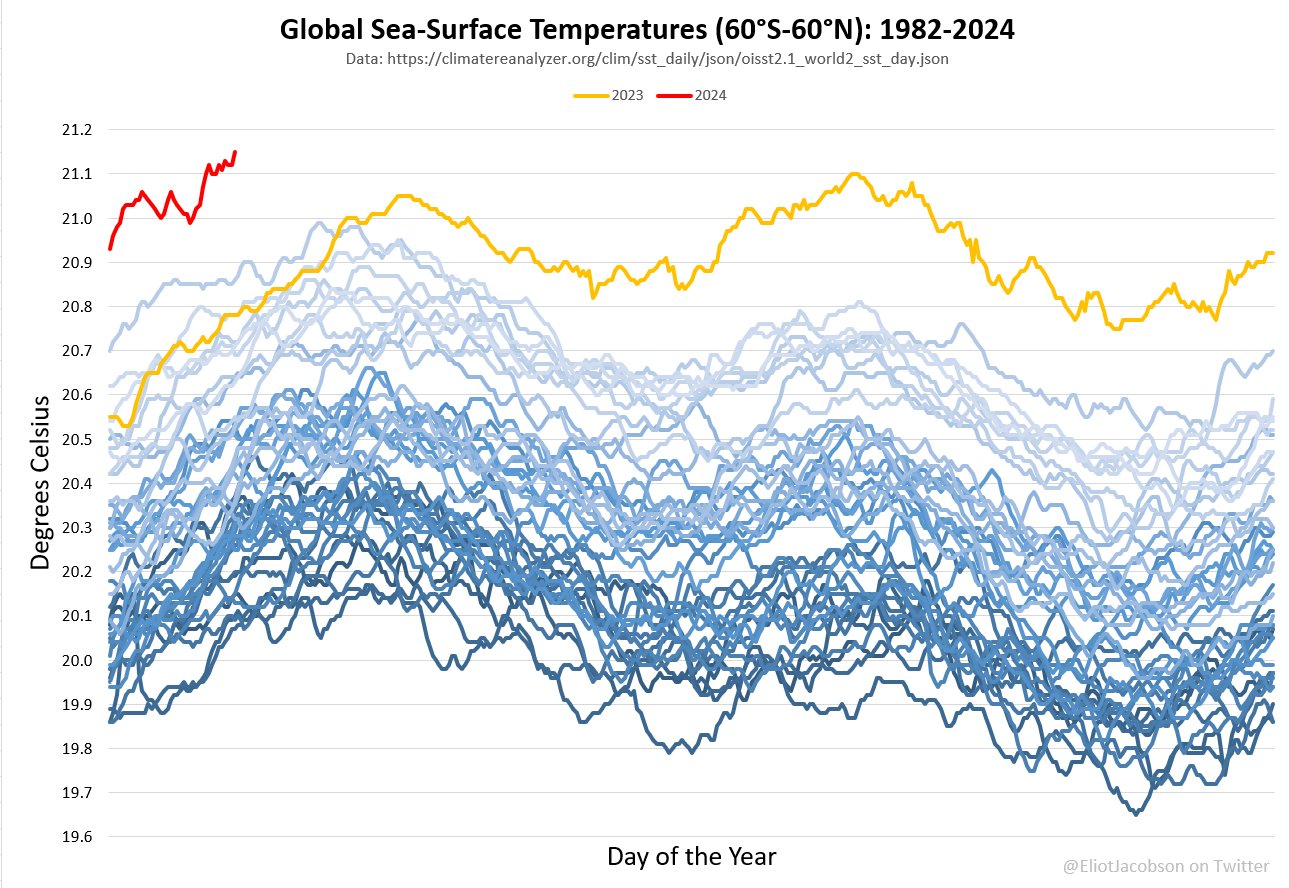
Graph by Eliot Jacobson, data from Climate Change Institute, University of Maine
The Antarctic sea ice volume is similarly off the charts, in a bad way (additional up to date graphs).
Climate scientists say they don’t know what is happening, although there is some speculation the spectacular Hunga Tonga eruption of 15th January 2022 might be involved. This eruption launched 100 megatons of water vapor into the atmosphere, something known to have a warming effect.
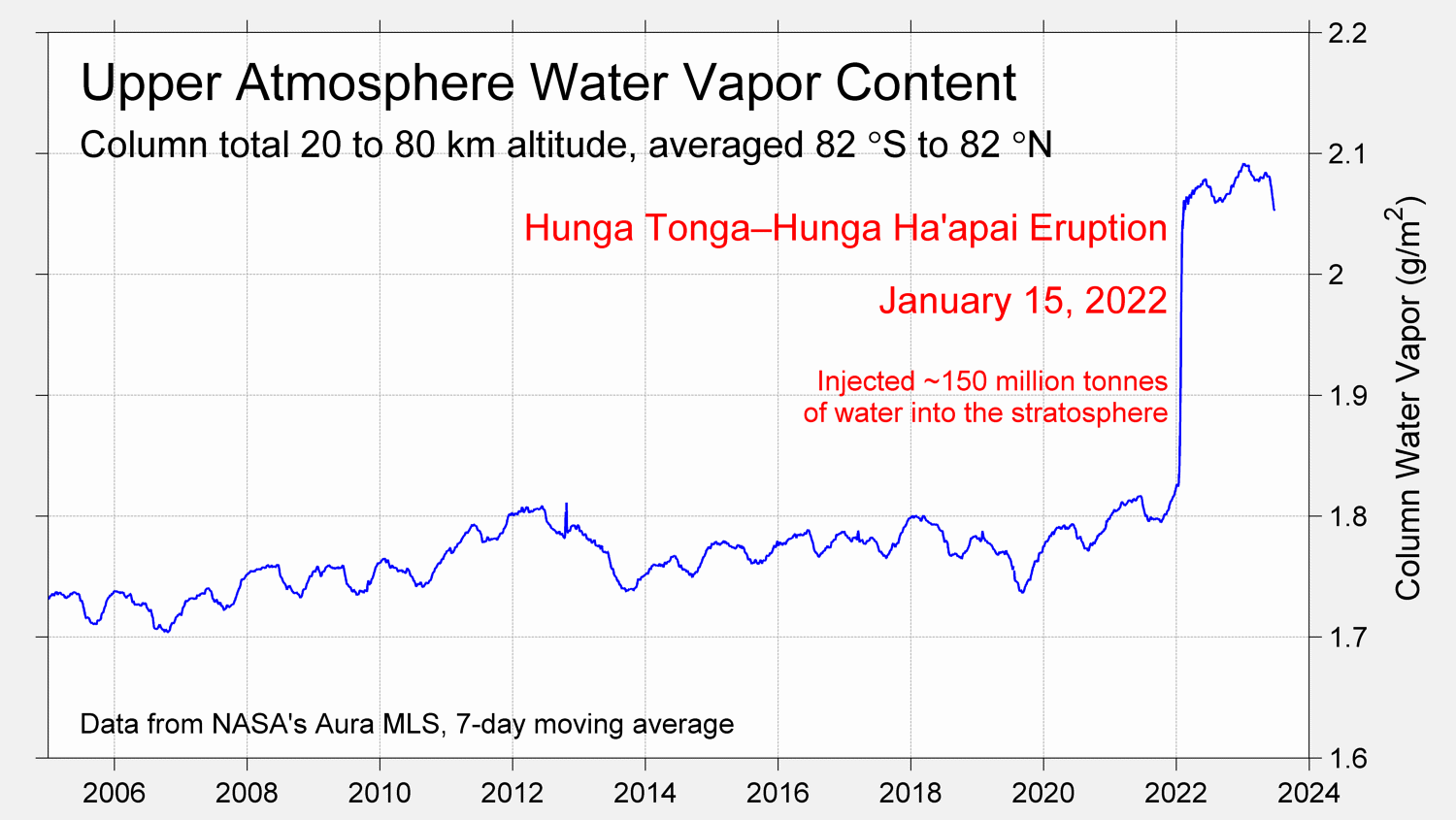
Yet another graph by Robert Rohde, data from NASA’s Microwave Limb Sounder (MLS)
Update: as of 2024, it appears the 2022 Hunga Tonga eruption was not a significant cause of the 2023 anomaly.
In addition, as of July 2023, an El Niño event has been declared, but the heating effects of that are not supposed to show up until much later this year.
Another suspect are the 2020 rules on ship’s sulfur emissions. Such emissions create aerosols, which have a cooling effect. Under the new rules, ships can emit seven times less sulfur, which might now be causing more warming, previously masked by aerosols.
Futhermore, it has been noted that 2023 has seen very limited distribution of Saharan sand. Also, it appears the sun is running a little bit hot.
As noted, our climate is not a simple pendulum that swings according to a repeating pattern. From the million year long history shown in the graph above we see that quite extreme shifts are possible, with temperature changes of over 9 kelvin.
Relevant here is that during the previous ice age, such changes sometimes also happened quite abruptly: “Shifts from cold stadials to the warm interstadial intervals occurred in a matter of decades, with air temperatures over Greenland rapidly warming 8 to 15°C”, from Abrupt Climate Change During the Last Ice Age. The article goes on to note that “the reason why Earth’s climate was so much more variable during the last ice age is still unknown”.
A perhaps more applicable model for our climate is this complex pendulum:

Screenshot from The Chaotic Pendulum by The Cardboard Channel
If you click on the video link, you’ll see a pendulum that frequently oscillates steadily, only to then move around and start swinging somewhere else entirely.
Ever more sophisticated climate models are being developed, but it is hard to incorporate everything. Even this week new simulations were announced that predict momentous changes in a major ocean_circulation, but there is no consensus yet if this model is right. (February 2024 update: things aren’t looking good).
A big problem is that many climate effects are unknown and/or hard to model. We also know of a bunch of tipping points where highly-nonlinear effects might suddenly happen. For example, permafrost thaw could abruptly release a lot of methane, a potent greenhouse gas in its own right.
What are we doing about it
We often hear governments are doing “nothing”, and simultaneously we get a lot of hype over countries managing to produce all their electricity from solar/wind for 12 hours straight. The reality is more complicated. The good news is that it really looks like that CO₂ emissions are no longer increasing, despite robust economic growth:
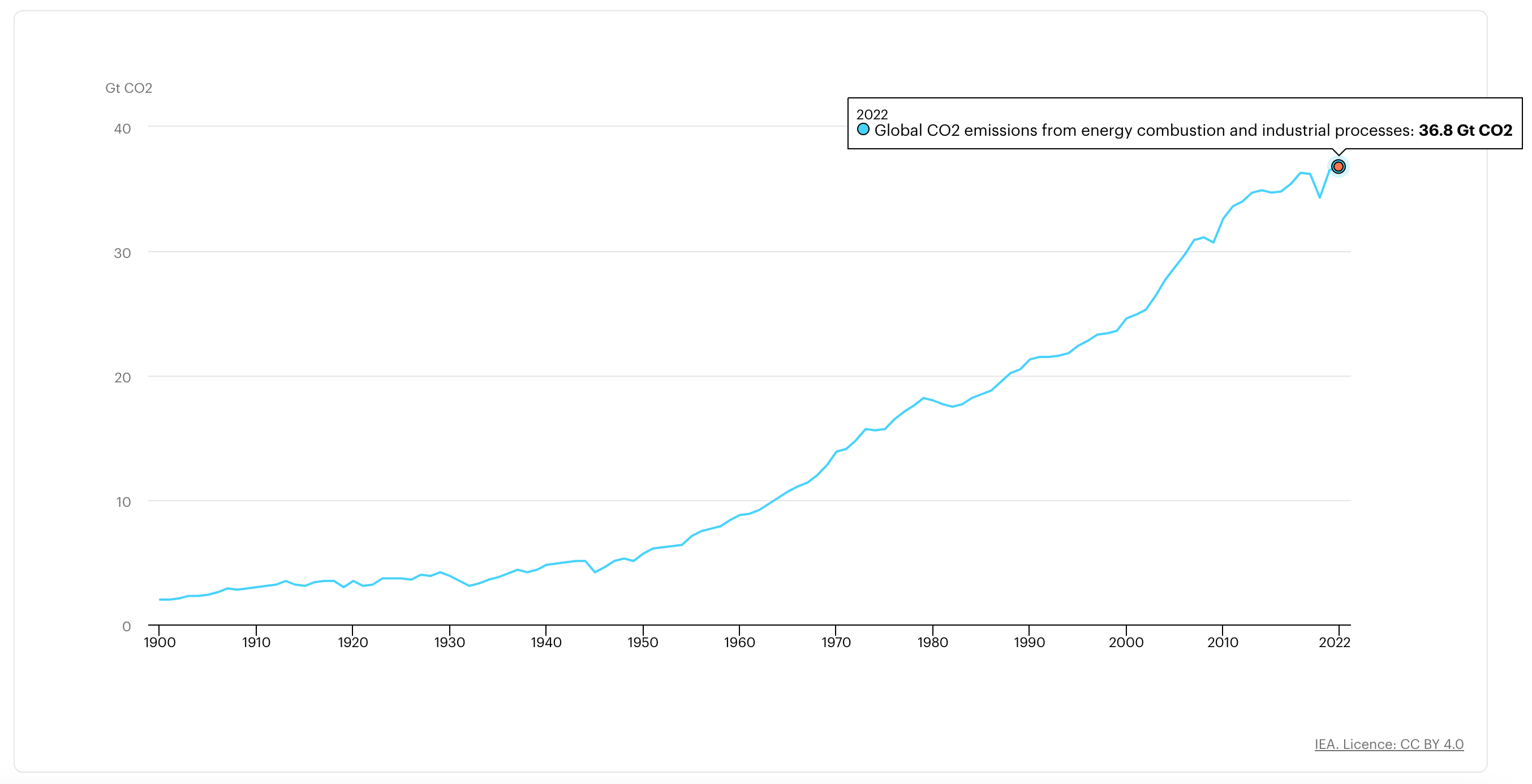
Source: International Energy Agency
There is also no shortage of plans. Various civil and green minded governments have committed to halving CO₂ emissions by 2035, and attaining “net zero” in 2050. Note that these commitments are all centered on trying to turn back the clock: stop doing what we were doing, and hope for the best. Also, the focus is almost exclusively on CO₂, despite global warming having more causes than that (like for example methane).
If you walk into a minefield, the best way to get out is to retrace your steps backwards. For global warming, we are doing exactly that. However, given the complexities of our Earth system, it is very much not guaranteed that things will then return to the “normal” of the past 12,000 years. Yet it is the best thing we can do right now.
Since CO₂ hangs round for a very long time, even if we’d stop all our emissions tomorrow, we’d still have to live with the impact of our (huge) emissions to date.
We are however not going to get our emissions down to zero in short order, mostly because politicians are pacing our efforts so no one is even slightly inconvenienced by them (more about which later).
There is no quick fix
From news articles and protests you might think our main focus should be on banning things like aviation. It turns out that while plane flights are an attractive target for protests, the entire aviation sector produces 2% of our CO₂ emissions (maybe 3.5% if you count more broadly).
In fact, nothing on its own really dominates:
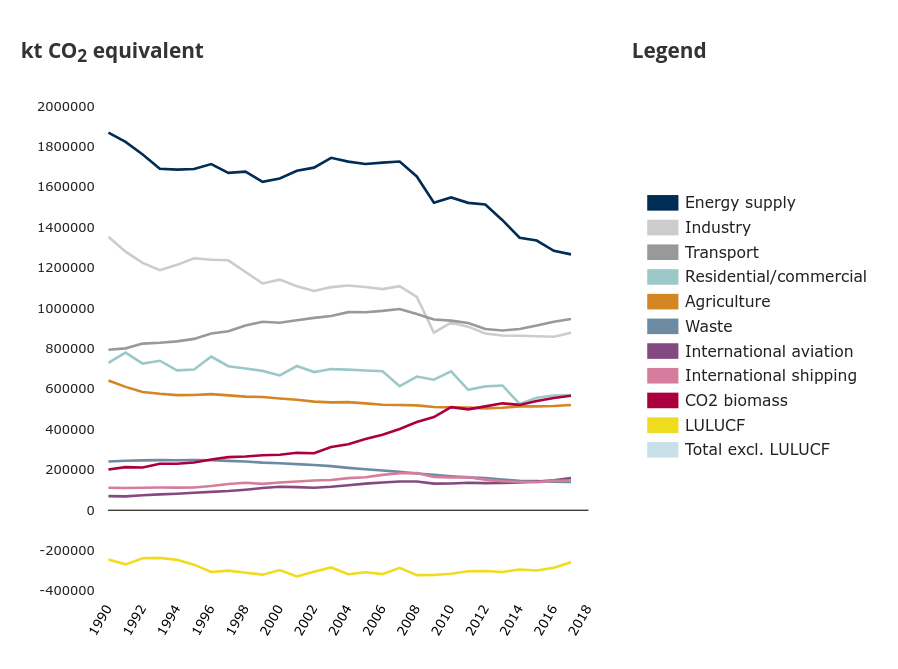
EU CO₂ equivalent emissions by sector. Source: EU Environmental Agency
I appreciate that every little bit helps, but no individual person is going to save the environment. We should all strive to minimise our emissions, but given how everything we do emits CO₂, we should be aware that ‘flight shaming’ is easily extended to everything else we do. Visiting your parents, having kids, buying clothes each emit far more CO₂ than aviation. Should we stop doing all that?
If we tell people all the emissions we cause are bad, we are actually saying that the only acceptable option is to walk to the pole circle (while planting trees along the way) and freezing yourself in the permafrost, thus restricting even your bodily CO₂ from entering the atmosphere for a while.
In reality, the way to save our climate is to make sure that the things we have to do anyhow do not emit CO₂. Don’t use more single use plastics than necessary, but also do not lie awake at night worrying how your straw usage is ruining the world. It would be good if we spent most time discussing the things with the biggest impacts.
It may be worthwhile to shift our eating patterns, but again, this will not in any way deliver a “quick fix”. The climate impact of beef appears to be a lot larger than straws and holiday flights combined though.
In terms of real impact, do vote wisely. You can achieve a lot more at the ballot box than in the supermarket. Also, you may not be able to convince climate deniers to change their ways, but you might be able to get reasonable people to actually go out and vote.
Earlier I wrote some words (in Dutch, German and a not as good version in English) on the benefits of spending time convincing reasonable people. You mostly won’t convince conspiracy theorists anyhow, and even arguing with them lends them credibility. It is far better to give good information to your more reasonable friends and family members (and get them to vote).
Finally, in further bad news, there are no quick ways to generate enough power by other means, either through the much vaunted small modular nuclear reactors, or via the still decades away nuclear fusion. The amounts of energy we need are such that no matter how hard we try, we can’t build any kind of nuclear reactor type fast enough to matter.
The renewable power revolution gives some hope
Yet, there is some hope. For ages, getting rid of our fossil fuel dependency was just a dream. Now, for the first time, it appears that clean energy might not only be cleaner, but actually cheaper. As of 2023, it is getting to be possible to create electricity from solar for something like 3 cents/kWh (dollars or euros), even when taking into account all costs.
This is less than a third of the money you’d have to spend to get this much electricity from natural gas (based on European August 2023 delivery prices).
Now, a lot of hard work remains to be done. This 3 cents/kWh does take into account that the sun often does not shine, for example. But although we now know in theory how to store solar power (by converting it to gaseous hydrogen), we still need to build all that.
I wrote a long piece in Dutch on what the plan appears to be to get to 100% renewable power and (hydrogen) storage. Automated translation often does a reasonable job on Dutch.
Solar electricity can now be compared to $20/barrel oil (assuming 40% efficiency converting oil to electricity). Given that actual oil trades for multiples of that in 2023, it is clear that (large) energy consumers will find a way to shift to that $20 price point somehow.
The difference for transport is even more stark. Excluding taxes, a liter of petrol costs around 80 eurocents as of August 2023. Six liters will drive a car around 100 kilometers. This would cost you around 5 euros. A similar trip with an EV would require 17kWh of electricity, which could cost 50 eurocents at solar prices. A clear 10-fold difference. Note that this is not theory, I’m charging my EV this week for 7 cents/kWh, which includes the punitive Dutch taxes.
Even when we are being very cynical, it is hard to see why the world would persist in burning fossil fuels once the cleaner alternative is so much cheaper (once all the infrastructure is done). No one loves petrol fumes that much.
However, it won’t happen soon enough
Lots of governments have pledged quite incredible reductions in (net) CO₂ emissions. But sadly, these commitments will not be met individually and definitely not globally. Here I look at the EU, since they’ve documented their pledges rather well, but similar stories hold for other countries/governments.
First individually. The EU has pledged to lower emissions in 2030 to 55% below 1990 levels. This sounds like more than a halving, but it is good to know that a 35% reduction has already been achieved between 1990 and 2020 (for real, not because of Brexit). As such, it may well be possible to achieve this target, although it is still very ambitious.
Twenty years later, the EU wants to achieve net-zero CO₂. If they really want to make this happen, it will require a complete industrial retooling. Note however the presence of the word ’net’ in there - this means the goal can be achieved while still burning fossil fuels, as long as the excess CO₂ is somehow siphoned off.

Source: Dutch government tweet. Presidents, (prime) ministers from France, Norway, Denmark, EU, UK, Belgium, Ireland, Luxembourg, Germany, The Netherlands, all committing to 120 GW of North Sea wind power by 2030 and 300 GW by 2050
The problem here is that to achieve the 2030 goal, stuff needs to happen today that is clearly not happening. If you plan to build 120 GW of wind power for example, you also need to build infrastructure to store excess energy - 120 GW will often overwhelm our daily needs. 2030 is only 7 years away, and by that time we’ll need gigawatt scale hydrolisers and hydrogen storage facilities. Yet, as of 2023, almost nothing is happening at that scale. In my own country of The Netherlands, we’ve been arguing over a 20 MW pilot plant for five years now. 20 MW. 0.02 GW.
Governments meanwhile have also been terribly slow with permitting, much as if there is no climate crisis going on.
One reason why things are bogging down is that politicians are pacing efforts so that no one is really inconvenienced. Policy makers experience backlash whenever people are forced to do something against their will. The 2023 climate anomalies may put an end to this problem though.
The 2030 goal could be reached by first doing the easy things: electrifying most of our transport, insulating our houses better, keeping them warm with heat pumps, rolling out ever more solar and wind for our electricity needs.
But after 2030, life becomes a lot harder. We use fossil fuels for way more things than electricity and heating. It is possible to retool our industries to use hydrogen and (confusingly) CO₂, but it is a lot of work.
We do know how to do it though.
Sadly, as noted, individual countries/governments can do a lot, but globally, many economies won’t or can’t join in. They might not have the will, they might not have access to sufficient capital to make the transition. It is also possible that a region does not have the organizational skills or simply the time to perform the transition, for example because a (culture) war might be going on.
Finally there is a pernicious effect - countries trying to do the right thing will all implement carbon pricing or other measures that make pollution more expensive. This strongly encourages industry to look elsewhere. In my own country (The Netherlands), our government’s official CO₂ figures are pretty upbeat. Until you factor in how much industrial production has moved elsewhere.
In this way, we can get lots of regions claiming to make good progress, and then there are other regions that do not report on their emissions.
24th of August 2023 Update: Both the EU and the US have passed or are working on laws that will make companies be responsible for ‘imported emissions’. In the EU this is called CBAM and in the US it goes by the name of Clean Competition Act, but it is not yet law. Neither of these mechanisms is active already, and it will take years before they are. And even then these are paper accounting mechanisms, which are often gamed.
In short - despite the best intentions and pretty impressive efforts by green minded countries and governments, we are not going to achieve “net zero” in 2050 if we stick to the current plans.
Carbon capture and storage
We have two problems - we are releasing too much CO₂ into the atmosphere, and the atmosphere already contains too much of it.
There is a lot of enthusiasm for greening up our energy and industrial systems so we emit less CO₂. This is the ‘walking back out of the minefield’ as noted above. In many circles, this is the only acceptable option.
For a long time, there have been investigations in capturing CO₂ as it is being emitted, but somehow many people see this as cheating. We should actually sacrifice more, and ‘just stop oil’, and not resort to hacks to lower our CO₂ emissions in any other way than to stop using non-renewable energy.
The problem here is that this is an ethical stance that may make life a lot worse in practice.
It also doesn’t help that there are a lot of people that hope we can just plant more trees and thus solve the problem naturally. Trees are amazing things, but they can only store CO₂ in their own trunks/roots. And if the tree dies, all that CO₂ eventually returns to the atmosphere. Even planting (and keeping alive) 1000 billion trees will capture at best around one third of all CO₂ we’ve emitted so far.
As an amateur biologist, using nature to capture CO₂ is a very fascinating idea to me. But since nature fundamentally runs on a CO₂ cycle, it is very hard to get biology to truly ‘fix’ CO₂ so it doesn’t (eventually) return to the atmosphere. We may one day create an organism that converts CO₂ directly into graphite (or diamond, while we’re at it). But we aren’t there yet.
There are many ways to extract CO₂ from the atmosphere and some of them are really blunt. For example, you could grind up a mountain and chuck it into the ocean. There, the ground-up mountain will absorb lots of CO₂, which in turn causes the ocean to suck up lots more CO₂ from the air. This grinding does require a lot of energy, but since we have ample nearly free solar power it could be done, and it delivers the scale of CO₂ capture that we need. Also, since there is so much sea, the impact on the atmosphere is relatively much bigger than on the ocean.
It is good at this point to examine our feelings about this idea. It might well sound terrible - what will all this rock do to the ocean? And what about the mountain, didn’t it have life? How dare we even ponder messing with the environment like that?
Now, contrast these thoughts with what we’ve been doing for the past few centuries.
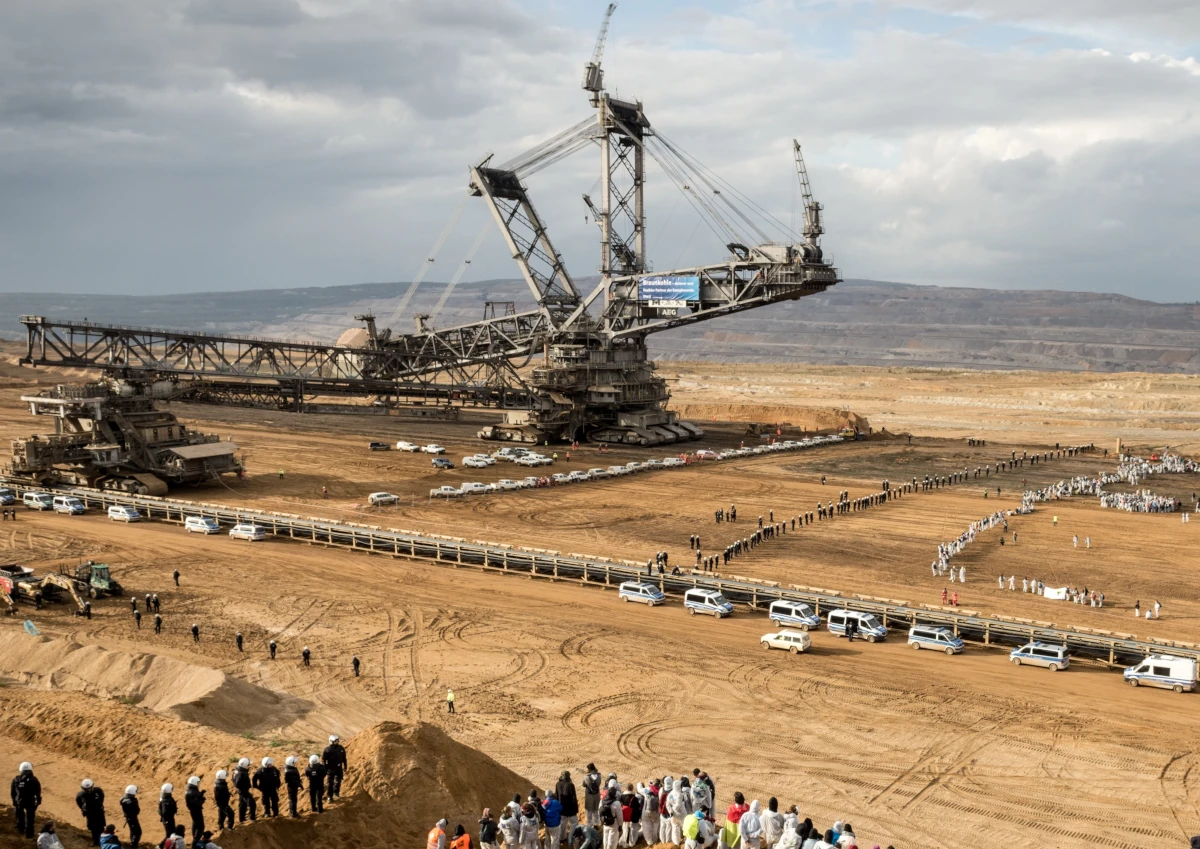
Source: Wikipedia. The Hambach open pit mine.
Was it ok to heavily mess with the environment in order to get the energy and chemicals we needed? But is it then not ok to consciously influence the environment to fix things?
I’m not hoping at this point to convince you of the righteousness of grinding up mountains and sinking them in the ocean. I’m not sure myself. However, we’ll soon been facing these kinds of choices given how wild the climate is right now.
Disney’s Fantasia captured our fear of poorly understood technology well in the Sorcerer’s Apprentice scene, where Mickey Mouse uses magic he doesn’t understand to make his life easier, and continues to go on to do ever more exiting things with it, only to eventually find out the magic is stronger than he is. In other places this story is known as Der Zauberlehrling.
We may also recall how Australia imported rabbits, which eventually multiplied into the billions, laying waste to local ecologies. Decades of battle using fences, poison and biological warfare followed. This too may have entrenched the idea that we should not attempt to outsmart nature.
The CO₂ capture/storage spectrum is not all about grinding up mountains. It is technically feasible to capture CO₂ while we are releasing it, and to store it in underground facilities (in hopes that it stays there). There are also initiatives like Paebbl which grind up olivine, and make it absorb CO₂ and turn it into building materials, which might be a safer solution.
Other people, like Terraform Industries plan to use sunlight and directly captured CO₂ to create natural gas which is then carbon neutral.
As noted, even relatively boring CO₂ emission prevention/capture has a bad rap. But this is as nothing compared to what follows now.
“Solar Radiation Management” is super cheap and can have rapid and significant effects
In 1974, Mikhail_Budyko first put forth the concept of solar radiation management. By injecting relatively trivial quantities of sulfur in the stratosphere, we can within a short few months block sufficient sunlight to cool the whole Earth significantly, enough that you’ll notice.
Soon after the discovery, many climate scientists felt that this was all too easy. A future might loom in which we continued to pollute the Earth with 1970-era manufacturing processes, and would paper over the associated global warming with a few planes injecting yet more pollution into the stratosphere.
Until around 2006, it was not considered polite within climate circles to even acknowledge the existence of this idea. And I guess with good reason - it is hard enough to get people to focus on cleaning up industry and energy as it is. If we’d chosen to simply cool down the atmosphere in 1980s, yet continued to emit vast quantities of CO₂, we’d be super hosed right now.
In 2006 Dutch Nobel Prize laureate Paul Crutzen used his fame and position to break the taboo on what he cleverly called Albedo Management. In this paper, Crutzen noted that cleaning up our emissions was wonderful, but that this would likely contribute another 0.8K of heating on average (and 4K in the Arctic), because this would get rid of aerosols that were previously helping cool the atmosphere. I think we are seeing this now.
However, he also described how the 1991 Pinatubo eruption cooled the Earth by around 0.5K in the course of 1992. It is estimated that the eruption added around 6.5 megatons of sulfur to the stratosphere. Further modeling has shown that if the stratosphere were dosed with between 1 and 2 megatons of sulfur per year, we could cancel out the effect of our greenhouse gas emissions. As of 2023, it is estimated that the cost of doing so would average out to a few billion dollars/euros per year.
In other words, it looks we could manage the Earth’s temperature in short order and cheaply too. One way is Stratospheric aerosol injection, which could happen using planes, artillery, balloons or even wilder ways.
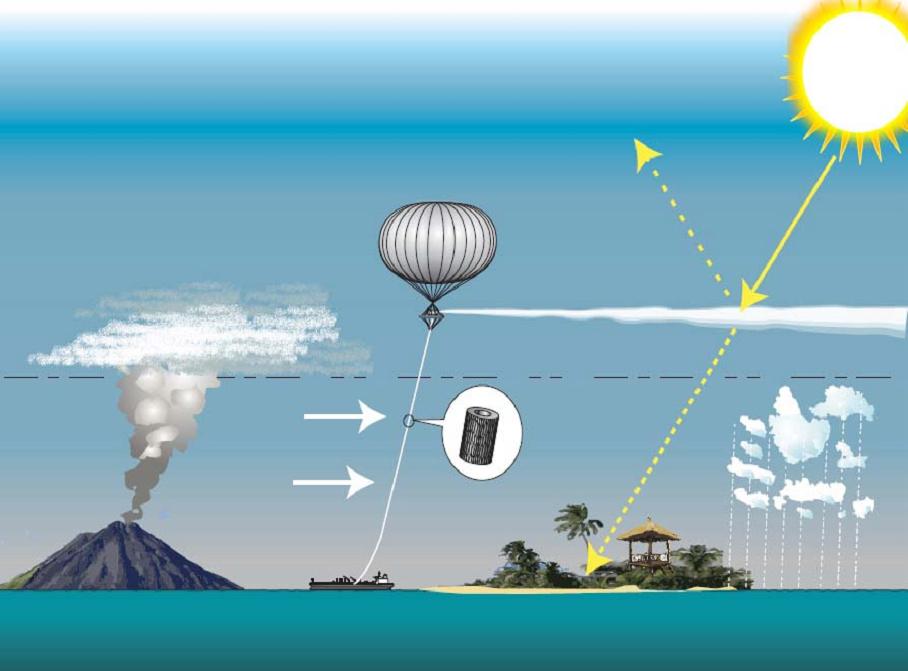
One way of doing it. Source: Wikipedia user Hughhunt.
The key concept is that the stratosphere, around 20 kilometers high, is relatively isolated from the rest of the atmosphere. Anything injected there will hang around for years, which means you don’t have to inject too much. In the stratosphere, chemical and micro-physical processes convert SO₂ into sub-micrometer sulfate particles, which reflect a tiny fraction of sunlight back into space (in the order of 0.1%). The fraction is small enough that it will not have a large impact either on plants or on solar cells, but it will whiten the sky somewhat.
Now, this idea is of course totally outlandish. This is two steps beyond efforts to capture and store our own CO₂ emissions. The concept has now been exercised for a few decades, and this has given us a reasonable understanding how it should be done, and what the effects would likely be. There are currently no red flags, except that we’ve not actually done this ourselves.
To be very clear, I’m not advocating to start doing this right now. But I am saying it is a possibility that should be investigated.
At this point, we might attempt to discard the idea based on how wrong it could go. However, things are already going pretty badly (see the terrible graphs above). People who study the politics of geo-engineering are now mostly saying it is not a question of if we’ll need to do this, but only exactly when we’ll do it.
While initially people were (unwisely) pondering geo-engineering so we could continue to burn coal and oil, it may now be a reasonable idea to temporarily cool the Earth while we stop emitting CO₂.
Now, experience shows that this concept is so alien, so science fiction, that it takes even optimistic people a lot of time to appreciate it.
Also, this page is not there to convince you it is a good idea. But it would be extremely unwise to blankly dismiss solar radiation management under any circumstances. Specifically, it is instructive to think when we would find the risks acceptable - how bad must things get before this starts to look like an option?
More research is clearly needed
Solar Radiation Management is at this point something scientists can credibly study, it is no longer a total taboo. However, it is also still something that is considered very controversial. There is not that much funding, and specifically, even the small proposed experiments have come under unjustified fire. Specifically, the Harvard Stratospheric Controlled Perturbation Experiment would release 1 kilo of chemicals in the stratosphere. Sadly even the initial test flight, without chemicals, got canceled because of the ‘moral hazard’ of doing this kind of research.
It would seem that with the climate going off the rails as quickly as it appears to be doing right now, we should be doing a lot of research to figure out our options. It is also somewhat worrying our best climate models currently don’t really know why we are having a 2023 anomaly (this paper predicted a small effect of the big volcano eruption).
Next to the admirable ’net zero’ goals, governments should robustly and enthusiastically fund research into climate engineering. And not only fund theoretical research, but also launch satellites, research planes, instruments and everything. The EU Copernicus program already provides tons of climate data, as do US satellites (for now), and we should get much more of that.
Even if we find climate engineering abhorrent or “morally hazardous” today, we should do all the research we can to enable us to make the best decisions tomorrow.
The good news is that both the EU and the White House have recently (June 2023) released statements supporting more research into solar radiation modification.
Exciting times
We are heading for some very exciting times. The climate is changing rapidly and with huge consequences. We know we are at fault. Many parts of the world are working on solutions, but it is not going to happen quickly nor universally enough. Meanwhile, for the first time in history, we have the possibility of consciously altering the climate in a direction we prefer.
And not only is this possible, it is cheap and easy. Signs are it could work if we think it through, but will we think it through well enough? Climate engineering is so cheap that it is within range of individual billionaires and even small countries.
This has led to speculation about a “Greenfinger” billionaire who might on his or her own decide to engineer a better climate.
Attempting to modify the climate is the prototypical “world affair” that would need careful international governance, something currently in very short supply.
We are creating a clean future!
One thing we might almost forget, with all this hard work to get to ’net zero’, we are making huge strides in cleaning up our emissions. By 2040, substantial amounts of our energy and industry will be powered by sun and wind. Coal plants in the western world are already shutting down at a rapid clip. By 2050, we may not have achieved real net zero, but we’ll have come a very long way.
And this allows me to whip out this classic:
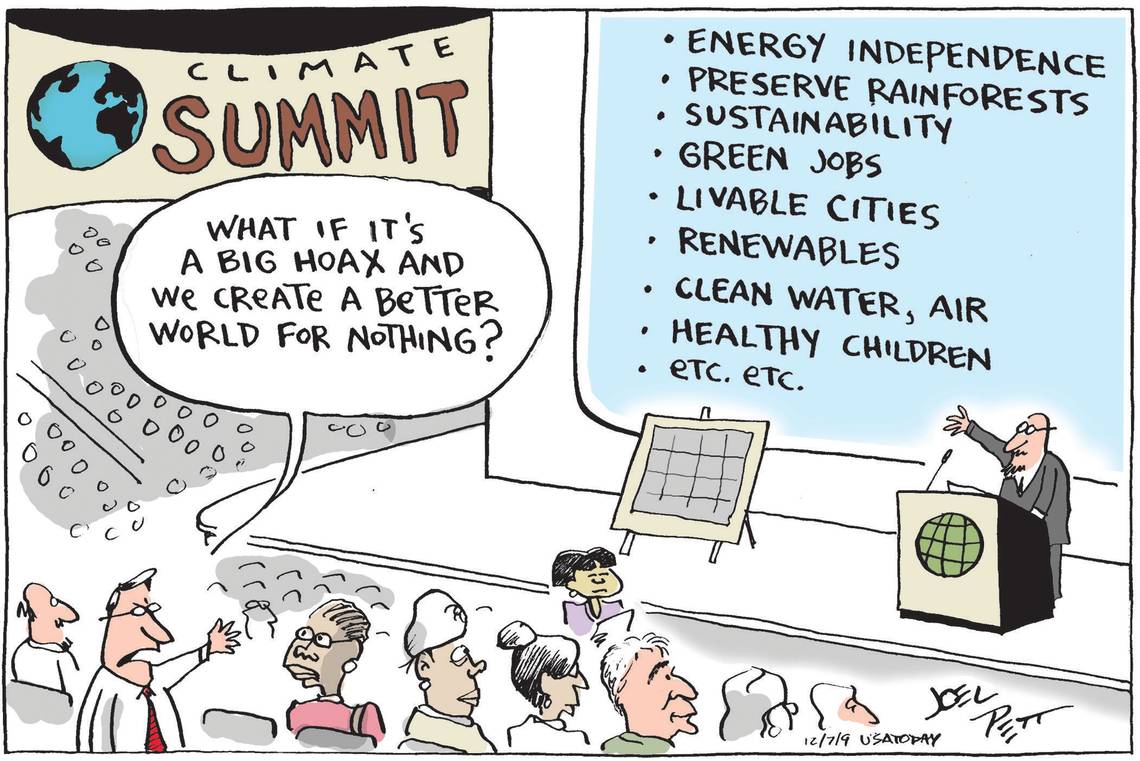
Source: Joel Pett.
Rounding off
In the content above, I hope to have helped create a useful mental image of the climate or “Earth system”, and our role within it, and how we might end up being forced to truly consider taking an active hand in managing our planet. I also sincerely hope that this leads to taking the possibility seriously, and especially that we’ll quickly start doing the research and building the infrastructure to do experiments to learn more about the potential dynamics.
We are very much in a climate emergency, but it is good to know there are options for the interim period in which we work on reducing our CO₂ emissions to zero.
If you have any feedback or questions after reading this post, please do contact me on bert@hubertnet.nl!
Further reading
A romping (if huge) read is Termination Shock by Neal Stephenson. This is a very well researched work of fiction, as is typical of Stephenson. The book has a significant Dutch component, describing many events in my home town, and I can personally vouch that those parts are truly spot on. I’m a great fan of learning by fiction, and this book is a very vivid depiction of where our climate is heading, and the kind of bad stuff that will happen more and more. Also, a very innovative way of delivering sulfur to the stratosphere is described.
The Planet Remade: How Geoengineering Could Change the World by Oliver Morton is an almost poetic description of the stratosphere and our Earth system. It also explores in depth the relation with our planet and the feelings around interacting with it or even proposing change.
Geoengineering: The Gamble, a brief but potent book by Gernot Wagner, a professor in climate economy at Columbia Business School. Explores the incentives around modifying the climate, and also sketches several scenarios on how things might play out. Light on the physics of it all but goes in depth on what governance might look like, and how this must involve the whole world. Also gives a good historical overview of geoengineering.

